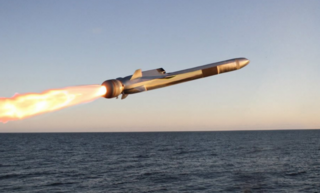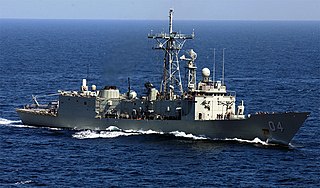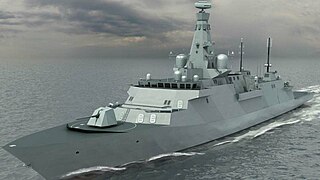Outcome and response
Tier 1





The government plans to upgrade the Tier 1 Hobart-class destroyers. [9] The major upgrades include increasing the Aegis Combat System from Baseline 8 to 9 and possibly upgrading the radar system. The shipbuilders will also alter the missile cells so as to accommodate for more advanced missiles such as the Tomahawk, the Naval Strike Missile, and the SM-6 anti-ballistic missile. [10] [11]
As a result of the review, the Department of Defence (DoD) has agreed to make various concessions to the Hunter-class frigate program, the largest of which perhaps being the reduction of the total order of vessels, of which the DoD has announced their intent to slash the program to six vessels instead of the original nine that were planned. [12] The DoD also followed the recommendation of the review to assess the feasibility of adapting the frigate to allow for the launching of the Tomahawk cruise missile. [13]
Tier 2
In response to the aging nature of the current Anzac-class frigates of the RAN and in accordance with the recommendations of the review, the DoD has announced their intent to procure 11 'General Purpose Frigates (GPFs)'. [14] They are intended to form part of a 'tier 2' fleet: less expensive than their 'tier 1' counterparts whilst still retaining adequate firepower, especially when it comes to Vertical launching system (VLS) cells. The GPFs will gradually replace the Anzac frigates as they come out of service, and the first batch is to be built in an accelerated manner overseas, and later transition to Henderson Naval Base for construction. [15] The DoD has outlined four shortlisted ships to be considered for the program: [16]
- German MEKO 200, the same design used for Anzac-class frigates. [17]
- Japanese Mogami 30FFM stealth frigate.
- South Korean Daegu FFX/Chungnam FFX frigate.
- Spanish ALFA3000 corvette, the same design used before the review to advocate for a 'Tasman-class' corvette. [18]
In November 2024, it was reported that the government had shortlisted the Japanese and German designs, with a finam decision expected in 2025. [19]
The DoD has announced as a result of the review their program to acquire six 'Large Optionally-Crewed Surface Vessels (LOCV)'. The intended role of these vessels is to act as crewed missile boats; they will have 32 vertical-launch cells, but few close-in weapons. [20] The DoD plans to purchase the ships from the United States contractors on their similar program, but to have them built in Australia. [21] The 32 VLS cells on the ship will allow the system to act as a launch arena for anti-ballistic missiles such as SM-3 and RIM-174 Standard ERAM as well as land-strike missiles and anti-air munitions. [21]
Tier 3
The review emphasised the belief that the Arafura-class is under-gunned and does not possess significant offensive or defensive capability, and as such, the DoD has agreed to reduce the amount of Arafura vessels from the planned twelve down to six vessels. [22] They also agreed to investigate whether the vessels could be used in a specialised role, such as mine countermeasure. [10]
The DoD has agreed to use the Cape-class primarily as an Australian Border Force vessel, as well as manufacture capability on a number of the vessels that would prove useful to the Navy. [23] The government has also agreed to put in place a framework that would allow for all Cape-class vessels to be under the overall responsibility of the Department of Defence, yet maintenance would be funded by the appropriate organisation (ABF or Navy). [24]
Shipbuilding
The review emphasised that the government of the day must commit to continuing Australia's domestic shipbuilding industry. As a result of this the government made various concessions to accommodate this with projects divided across Australia's two manufacturing naval bases. These projects are: [25]
- At Osborne Naval Base in South Australia;
- Upgrading all Hobart-class destroyers;
- Ensure all six Hunter-class frigates be built efficiently;
- Life of Type Extension (LOTE) upgrades of Collins-class submarines;
- 3 replacement destroyers for the Hobart-class to be built following completion of the Hunter program;
- At Henderson Naval Base in Western Australia;
- Construct 8 out of the 11 General Purpose Frigates;
- Build all of the 6 Optionally-crewed missile boats; and
- 2 additional evolved-Cape-class patrol boats.
South Australian Premier, Peter Malinauskas praised the government's allocation of shipbuilding programs to South Australia. [25]














